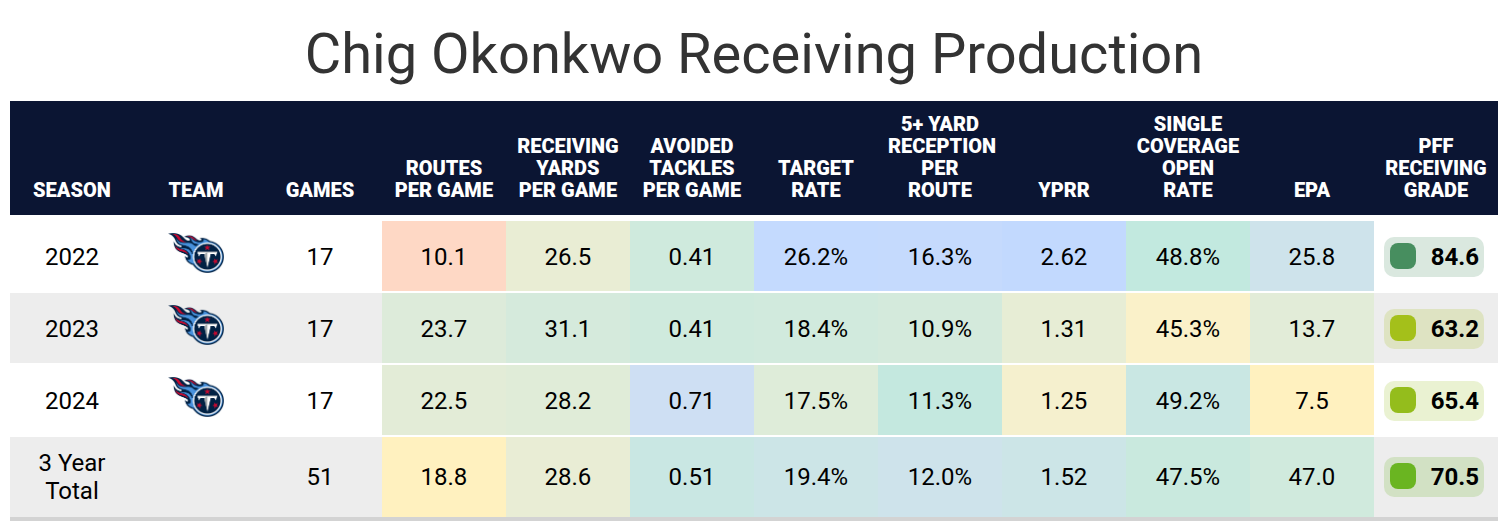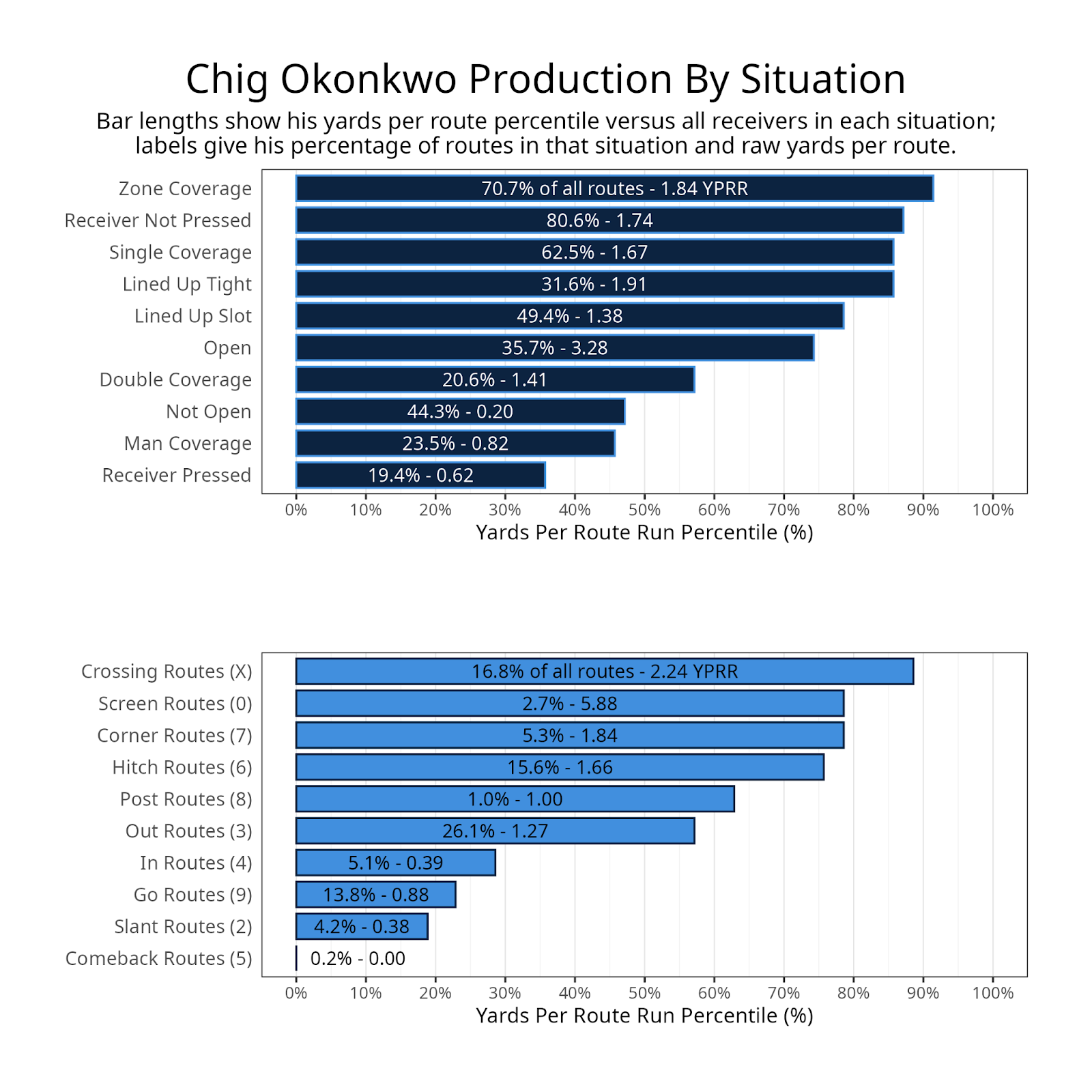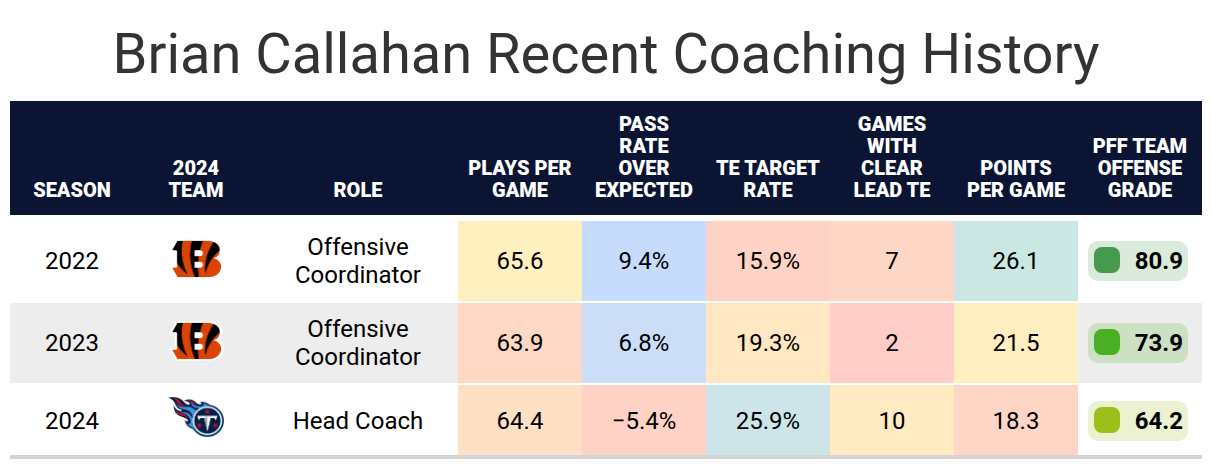
- Chig Okonkwo was the fantasy sleeper after his rookie season: Okonkwo’s efficiency was off the charts as a rookie, but he wasn’t able to mix great play with high route totals until the 2024 fantasy playoffs.
- Potential for top-12 finish: If Okonkwo maintains his increased late-season snap share and builds chemistry with Cameron Ward, he has the potential to be a top-12 fantasy tight end for the Tennessee Titans in 2025.
- Subscribe to PFF+: Get access to player grades, PFF Premium Stats, fantasy football rankings, all of the PFF fantasy draft research tools and more!
Estimated Reading Time: 5 minutes

PFF’s Fantasy Football Player Profile series delivers the most in-depth fantasy football analysis available for the 2025 season.
Using PFF’s exclusive data, we evaluate player performance, competition for touches and how teammates and coaching staffs
Last updated: 7:15 a.m. Thursday, June 19
Player performance
Chig Okonkwo was a fourth-round pick by the Tennessee Titans in 2022 as an undersized tight end with excellent speed and athleticism. Over the last three seasons, the only tight ends who have been faster are Jonnu Smith and Darren Waller, based on NGS tracking data.
Okonkwo started his career third on the Titans’ depth charts. Austin Hooper was the primary receiving tight end, Geoff Swaim was the primary blocker, and Okonkwo was the primary backup in both. He was excellent on a per-play basis, finishing with a high target rate on his limited routes. His 2.62 yards per route run was tied for the most by a tight end in a season in the last three seasons. He was tied with George Kittle from this season, and the third-place tight end finished with 2.23 yards per route run.
The Titans moved on from both Hooper and Swaim for 2023, adding Trevon Wesco to be their blocking tight end. They drafted Josh Whyle and had Kevin Rader also play notable snaps. The Titans’ run-first offense limited his routes even though he was on the field for a high percentage of pass plays. His 403 routes were the 18th-most among tight ends despite playing every game. His big plays disappeared, and he was remarkably average. His yards per route run were cut in half, but his routes more than doubled, leading to a slight increase in fantasy points.
The Titans gave Josh Whyle a more prominent role in 2024 and swapped out Wesco for Nick Vannett. The Titans ran more plays in 2024 and asked the tight ends to stay in and block less often, leading to more routes run by their tight ends but a lower percentage of those were by Okonkwo. He started avoiding more tackles, but his quarterbacks weren’t necessarily taking advantage. His 0.71 avoided tackles per game was the sixth-most among tight ends.
Okonkwo’s role in the Titans’ offense evolved as the season progressed. He averaged 57.4% of Tennessee’s offensive snaps over the first 10 weeks of the season, and that increased to 72.4% over the next seven weeks before suffering an abdominal injury early in Week 18. He caught a 70-yard touchdown pass in Week 12, leading to a higher target rate over the rest of the season. In the fantasy playoffs, he caught 22 passes for 182 yards, along with a 17-yard run. While he couldn’t be used as a fantasy starter throughout the fantasy regular season, his 43.9 fantasy points during the playoffs were the fourth-most behind Trey McBride, Sam LaPorta and George Kittle despite not scoring a touchdown.
After the season, head coach Brian Callahan had plenty of great things to say about Okonkwo’s development as a tight end, which is a promising sign for his future.


Projected role
The Titans opted not to re-sign Vannett but instead drafted Gunnar Helm in the second round. Helm will likely compete with Josh Whyle for the run blocker role on early downs and two-tight-end sets. Going back to head coach Brian Callahan’s days with the Cincinnati Bengals, they typically had a bigger run-blocking tight end like C.J. Uzomah or Drew Sample and smaller receiving tight ends like Tanner Hudson, Irv Smith Jr. and Hayden Hurst. Helm never graded particularly well as a run blocker, but he had plenty of experience as a blocker at Texas.
Ideally, Okonkwo will pick up exactly where he left off last season. In his last two healthy games, Okonkwo played 76% of Tennessee’s snaps in 11 personnel, 87% of the 12 personnel snaps, and 100% of the 13, 21 and 22 personnel snaps. If Okonkwo continued this for the whole season, that would be excellent for his fantasy potential.
Okonkwo would have finished 16th in fantasy points per game among tight ends if he had his late-season route rate mixed with his season-long production per route.
The Titans made several changes to their wide receiver room, adding Tyler Lockett, Van Jefferson and several Day 3 and undrafted rookies. That, mixed with Calvin Ridley, gives Okonkwo minimal competition for targets relative to all other tight ends in the league.


Impact of teammates
Okonkwo will be in his second season with Brian Callahan as head coach. His offense looked very different in Tennessee compared to the Cincinnati Bengals without Joe Burrow, Ja’Marr Chase or Tee Higgins. The Titans ran the ball much more often and were more willing to throw to tight ends.
There is a chance the Titans will be more pass-heavy this season with Cameron Ward at quarterback. Ward had a low deep target rate, low first read rate and great accuracy on short passes, which is all good news for Okonkwo. However, Ward also doesn’t have a lot of experience throwing to tight ends. There is a chance Okonkwo finishes second on the team in targets, but that depends completely on his ability to gain chemistry and Ward’s trust.


Bottom line
Okonkwo has shown he has the speed and big-play ability to be a fantasy starting tight end and has had the playing time to be a fantasy starter. He didn’t put that all together until the last few weeks of last season. Okonkwo can be a top-12 fantasy tight end next season if he keeps the playing time he had to end last season and gains chemistry with Cameron Ward.

Footnotes
- Statistics in tables and charts were chosen based on their ability to predict future fantasy performance on a per-game or per-opportunity basis or to describe the player relative to others at the same position.
- “Opportunities” are defined as passing dropbacks, rushing attempts and routes run as a receiver.
- Numbers are provided either by season or based on the past three years. For rookies, only college statistics are included. For non-rookies, only NFL statistics are considered, regardless of whether they played in college within the previous three years.
- As college competition is easier than NFL competition, most rookies are likely to see a decline from their historical numbers.
- Only FBS data is considered for college players and comparisons.
- Kneel-downs are removed from rushing data to provide cleaner quarterback rushing rate statistics.
- The table colors in this article range from blue (indicating good/high) to red (indicating bad/low).
- All percentiles and color codings compare the given player to others with a high sample of opportunities. Generally, the cutoff is one-third of the possible opportunities in the sample. If a player does not meet the threshold, they are still included in the comparison, though their results may appear better or worse than expected due to the smaller, less predictive sample size.
- Information on utilization classifications and their importance can be found here for running backs, wide receivers and tight ends.
This news was originally published on this post .





Be the first to leave a comment